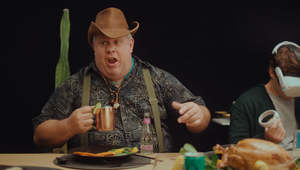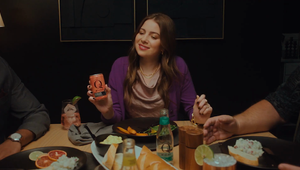
DDB’s Matt Blitz on Building the Production Plane While Flying It

Nashville-based production company Gear Seven pushes the limits of creativity, technology and possibility - and innovates like it’s nobody's business. Alongside a non-exclusive roster of directors and production capabilities, Gear Seven offers hardware, LED volume studios and virtual production via its sister companies Shift Dynamics and Arc Studios.
Gear Seven has teamed up with LBB to speak with agency production leaders about innovations in production technology and how it’s revolutionising commercial production. This series investigates the importance of education in this area for agencies and brands and offers a fun opportunity to nerd out on all things technical, while sharing memories of their most awe-inspiring and unforgettable moments on set.
The latest interview is with Matt Blitz, the head of integrated production at creative agency DDB Chicago. Leading the production department he oversees producers, business affairs and traffic, as well as playing a key role at the ‘Works’, DDB's internal studio. Leveraging his years of experience as a future-thinking, creative producer, he also mentors up-and-coming producers - a significant point of pride for him, next to his over 300 awards and accolades from the likes of Cannes, D&AD, Clios and the One Show.
Speaking to LBB’s Ben Conway, Matt discusses the production technology innovations that have inspired him throughout his career - from working with CGI dinosaurs for Disney to building a hydraulically-lifted hair salon for Starburst. He touches on the extraordinary impact of drones, the eternally awe-inducing Steadicam, and why we need to build more trust in producers.
LBB> Throughout your career – what has been the most exciting or groundbreaking piece of ‘new’ kit or technology that was introduced to you and why?
Matt> OK, so this may not be the most popular answer with some celluloid lovers but the most groundbreaking tech, to me, is the digital camera. As much as I love film - I mean, who doesn’t - the digital camera revolutionised the industry by cutting film and processing costs, and cutting time by ridding us of reloading and hairs in the gate. There was always a risk of film being exposed or other vulnerabilities that could require reshooting or the loss of a project. I started out as a PA in film and television and had to run film at the end of a long day for processing then had to pick up the dailies the next morning. I am sure no one misses those days.
LBB> And what are the technologies that you have your eye on now that either are having a big impact on how production is done - or have the potential to change things in a big way?
Matt> Who can deny that drones completely changed production? Remember the days when we had to hire helicopters to mount the cameras and fly around to get aerial shots? This was expensive and time-consuming. Also, no matter how good the rigger was, the camera still had a shake to it. With drones, we can effectively capture the same footage with fewer passes and less time, less noise and less waste. When we shot ‘Ostrich’ for Samsung, if we didn’t have a drone for our ariels, we probably would have been down five birds.
LBB> What piece of kit still makes you feel in awe when on set?
Matt> Honestly, it’s the Steadicam. I know this has been around forever, but I am always in awe when I watch the takes on set of epic Steadicam shots. The choreography and shot journey these Steadicam operators perform always make me feel in awe, not only of the tech but the performance of the operator as well.
LBB> Can you talk us through one or two of the most exciting recent productions that you’ve been involved in that you think had a really interesting innovation or technological aspect to them?
Matt> When we did the ‘Last Work Holiday Party’ for Miller Lite, we used 3D mapping of models to help create the likeness for our statues. These models were brought into a room with hundreds of cameras that mapped them in the poses that we wanted their characters to be modelled. The artist/director directed them to create a performance that was featured in the art exhibit at LACMA.
Another project that amazed me was for Starburst Swirlers. We created a spot that was for social and was shot vertically, like the candy, to allow the viewer to experience the ad 9x16. We built a hair salon set to be hydraulically lifted to be vertical. We harnessed the actors into the set but made it only for safety. They had to control their own body movements while being sideways. We then used a Super Technocrane to slide in and out of the set to capture the performances. Without the Super Technocrane, I’m not entirely sure how we would have been able to shoot vertically with a practical approach.
LBB> A similar question but it doesn’t have to be recent - what is the time in your career that you’ve been on set/observing a production and been particularly in awe of what the production team was pulling off?
Matt> When I was a 2nd AD in film, I worked on a movie for Disney called ‘Dinosaur’. At the time, it was revolutionary. The entire film was shot with live-action plates with CGI dinosaurs. I was on the Death Valley unit and we were responsible for filming a fight scene during the dinosaur migration. We went out to tech scout for two weeks with a survey crew and brought back a lot of data for the animators to previz out the results. Once this was ready, we headed back out to Death Valley where we shot with motion control. It was amazing to watch. For the fight, we had a mechanical FX team that had dug out areas and used hydraulic shovels that were triggered by the motion control system to throw dirt as the dinosaur would fall to the ground, simulating the impact.
LBB> Virtual production is growing in popularity in film and TV, what are your thoughts about its potential in the advertising space?
Matt> I feel the virtual set is going to be the next tech that will make the biggest impact on the industry. This could be another game changer for cost and timing that impact most productions these days. I know that sometimes we will still require a plate shoot to get the virtual backgrounds but in a lot of cases, we can use existing stock and/or computer-generated backgrounds. Not only is this a potential game changer for costs and timing but also for our industry's carbon footprint. Think about it, fewer set builds, less time in vehicles making company moves, minimising the waste we produce.
LBB> It can involve quite a different workflow/process - is that something you feel agencies and brands need to educate themselves on or does it lie with the production company?
Matt> I think agencies should educate their client partners on this new way of working. One of my biggest concerns industry-wide are brands not understanding production. This creates tension and a distrust of producers, and it is our responsibility to educate clients so they have an understanding and can make educated decisions on our recommended production approach.
LBB> With so many platforms to produce for, what’s your preference, to maximise assets across platforms or to produce content that’s more tailored to each content - or some sort of balance? What sort of conversations do you tend to have about this sort of thing?
Matt> I think the best platform to maximise deliverables is experiential. Budgets are shrinking but the appetite for PR hits and content is not. So, I believe, if we can create an amazing buzz-worthy experience and capture content from the experience, we can be hugely efficient with budgets while delivering a ton of content that can span across social, TV, etc.
LBB> Quite often production involves trying to solve a problem that’s never been attempted before - and that can mean hacking existing technology or trying to find new technologies. When you get a project that has such technological challenges, how do you and your team like to approach them?
Matt> This is absolutely a challenge for producers and why producers are more valuable than ever. I would love to have a process where we have a small R&D budget to make it more palatable to our tech partners to try and help us figure out these challenges but that doesn’t seem to be a feasible ask at this time. So, we tend to go to our most trusted partners and ask for them to help us out in hopes of the project becoming a reality. Honestly, the other challenge is convincing clients that the idea is feasible once we know. A lot of the time, ideas are feasible in some way, but the execution may have to shift to allow for timing, budget and tech reality.
We need to build more trust and understanding that these projects are a journey and require the client and agency to hold hands a bit as we build the plane while flying it.















